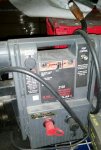jpg
Member
- 611
- 15
- 18
- Location
- Boston, MA
I keep a 3' length of stainless steel resistor for that purpose, it was part of an industrial heating element. I wired a slave cable plug for power. Works great!By the way, the output of mine is run through a tapped series of copper coils that act as a big series resistor, limiting current but allowing full voltage for striking the arc.




